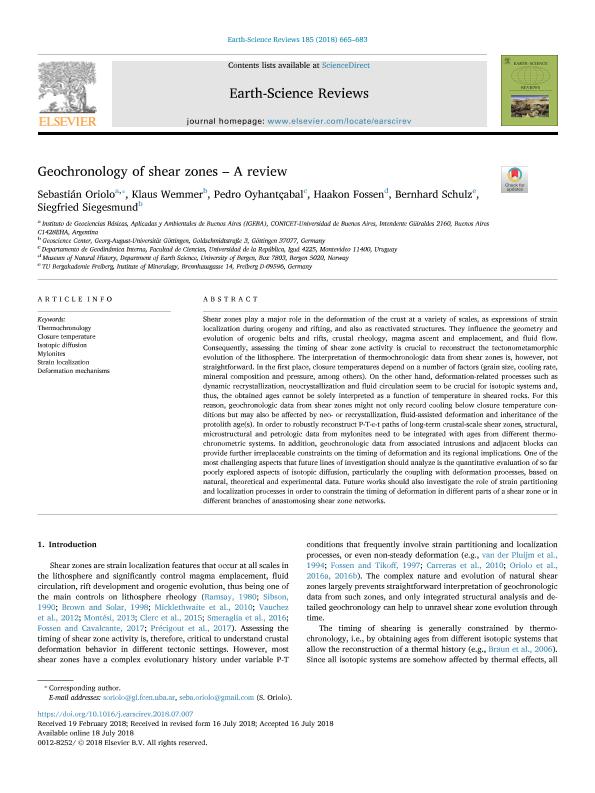Artículo
Geochronology of shear zones – A review
Oriolo, Sebastián ; Wemmer, Klaus; Oyhantçabal, Pedro; Fossen, Haakon; Schulz, Bernhard; Siegesmund, Siegfried
; Wemmer, Klaus; Oyhantçabal, Pedro; Fossen, Haakon; Schulz, Bernhard; Siegesmund, Siegfried
 ; Wemmer, Klaus; Oyhantçabal, Pedro; Fossen, Haakon; Schulz, Bernhard; Siegesmund, Siegfried
; Wemmer, Klaus; Oyhantçabal, Pedro; Fossen, Haakon; Schulz, Bernhard; Siegesmund, Siegfried
Fecha de publicación:
10/2018
Editorial:
Elsevier Science
Revista:
Earth-science Reviews
ISSN:
0012-8252
Idioma:
Inglés
Tipo de recurso:
Artículo publicado
Clasificación temática:
Resumen
Shear zones play a major role in the deformation of the crust at a variety of scales, as expressions of strain localization during orogeny and rifting, and also as reactivated structures. They influence the geometry and evolution of orogenic belts and rifts, crustal rheology, magma ascent and emplacement, and fluid flow. Consequently, assessing the timing of shear zone activity is crucial to reconstruct the tectonometamorphic evolution of the lithosphere. The interpretation of thermochronologic data from shear zones is, however, not straightforward. In the first place, closure temperatures depend on a number of factors (grain size, cooling rate, mineral composition and pressure, among others). On the other hand, deformation-related processes such as dynamic recrystallization, neocrystallization and fluid circulation seem to be crucial for isotopic systems and, thus, the obtained ages cannot be solely interpreted as a function of temperature in sheared rocks. For this reason, geochronologic data from shear zones might not only record cooling below closure temperature conditions but may also be affected by neo- or recrystallization, fluid-assisted deformation and inheritance of the protolith age(s). In order to robustly reconstruct P-T-ε-t paths of long-term crustal-scale shear zones, structural, microstructural and petrologic data from mylonites need to be integrated with ages from different thermochronometric systems. In addition, geochronologic data from associated intrusions and adjacent blocks can provide further irreplaceable constraints on the timing of deformation and its regional implications. One of the most challenging aspects that future lines of investigation should analyze is the quantitative evaluation of so far poorly explored aspects of isotopic diffusion, particularly the coupling with deformation processes, based on natural, theoretical and experimental data. Future works should also investigate the role of strain partitioning and localization processes in order to constrain the timing of deformation in different parts of a shear zone or in different branches of anastomosing shear zone networks.
Archivos asociados
Licencia
Identificadores
Colecciones
Articulos(IGEBA)
Articulos de INSTITUTO DE GEOCIENCIAS BASICAS, APLICADAS Y AMBIENTALES DE BS. AS
Articulos de INSTITUTO DE GEOCIENCIAS BASICAS, APLICADAS Y AMBIENTALES DE BS. AS
Citación
Oriolo, Sebastián; Wemmer, Klaus; Oyhantçabal, Pedro; Fossen, Haakon; Schulz, Bernhard; et al.; Geochronology of shear zones – A review; Elsevier Science; Earth-science Reviews; 185; 10-2018; 665-683
Compartir
Altmétricas



